Bursitis: The Fallen Heroes of Joint Mobility
Posted on 8/24/17 by Marian Siljeholm
Like being able to move? Me too. Mostly from the couch to the fridge and back. Kidding. Sort of. Regardless of the degree of shame associated with your motivation for movement, the odds are that you enjoy the ability to do so. And if I’m right, you owe a huge thanks to ... drumroll please ... a whole lot of small fluid-filled sacs called bursae. Oh. Seem anticlimactic? Not so fast. And just like every complex, important set of structures within the human body, this system of unsung heroes can go awry. And when it does, bursitis occurs. (Cue collective groan from the tennis players among us.)
Let’s take a look.
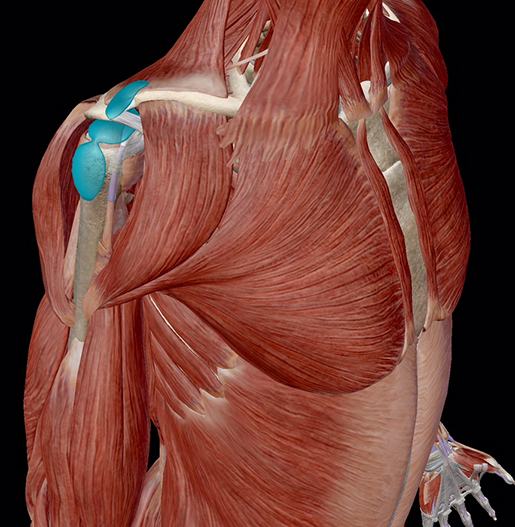 Image from Muscle Premium.
Image from Muscle Premium.
Want to learn more about bursae? Check out our free eBook!
Typically the result of sports-related injuries, bursitis is most likely to occur as the result of either a trauma or frequent repetitive motion of a particular joint, and thus within the areas that perform that frequent repetitive motion, such as the shoulder, elbow, hip, and knee. But beware, non-athletes among us (definitely not speaking for myself), bursitis isn’t reserved for the sporty types; it can also be caused by arthritis or a bacterial infection.
On good days the bursae cushion our bones, tendons, and muscles near the joints without you knowing they’re there, but on bad days they announce their presence with a painful vengeance within one or several potentially problematic regions including:
Elbow: Because the elbow is an essential part of many activities, like throwing a ball or swinging a tennis racket, elbow bursitis is incredibly common.
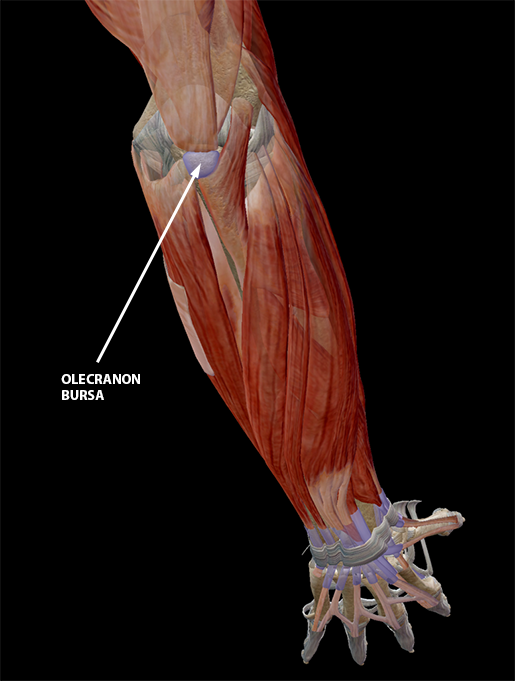 Image from Muscle Premium.
Image from Muscle Premium.
Knee: Falling directly on the knee or any activity that requires long periods of kneeling can cause bursitis in the knee.
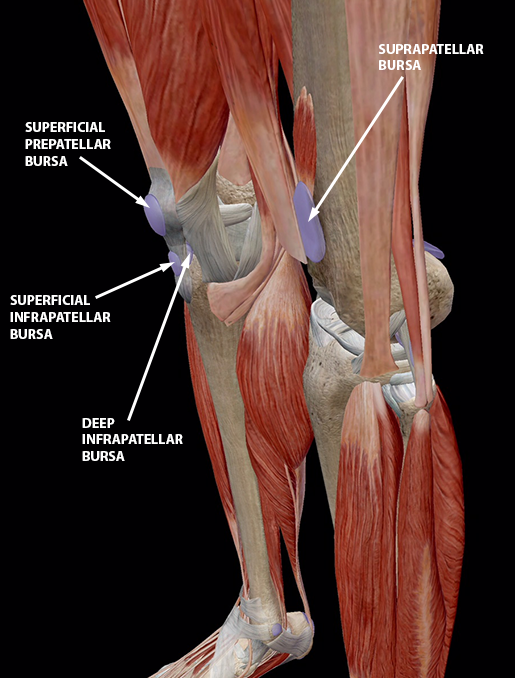 Image from Muscle Premium.
Image from Muscle Premium.
Hip: Runners are often susceptible to bursitis of the hip due to constant stress on the joint.
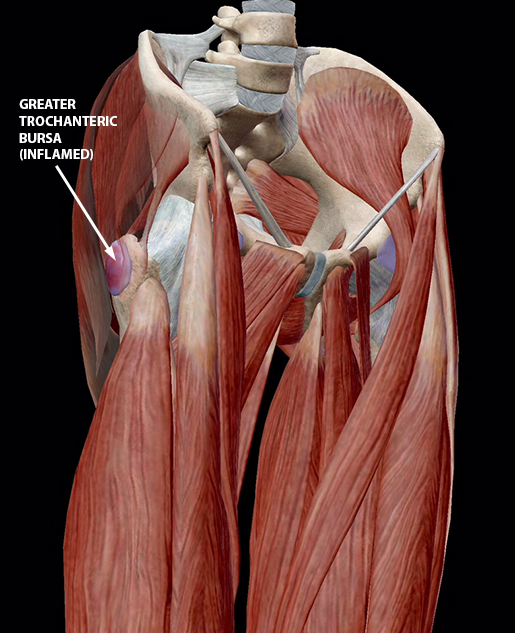 Image from Muscle Premium.
Image from Muscle Premium.
Shoulder: Bursitis of the shoulder is perhaps the most notorious of the bursitis-prone locations and can result from an awkward fall or, more commonly, the repetitive movements common in overhead sports such as swimming, baseball, and tennis.
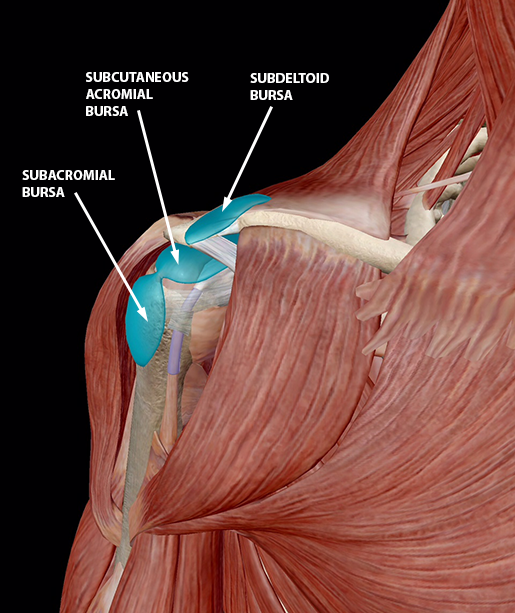 Image from Muscle Premium.
Image from Muscle Premium.
Ankle: Cool it, hurdlers of the track, we can’t all be Olympic athletes, despite your killer moves on the trampoline. (Is “tramping” still a thing? I hope not.) Anyway, those who go overboard with jumping, running, or even walking can develop the less common though certainly no less painful ankle bursitis.
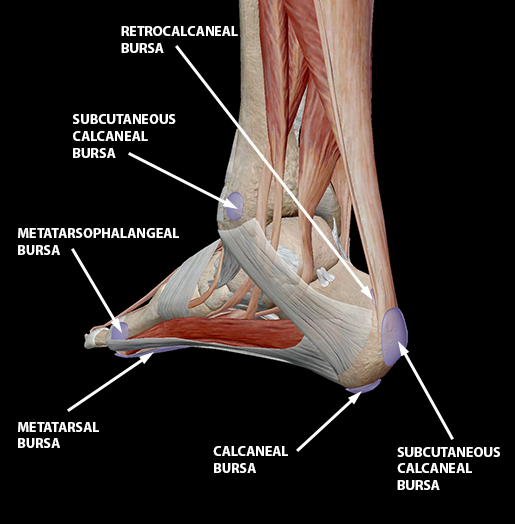 Image from Muscle Premium.
Image from Muscle Premium.
Ok, so you’ve got 99 problems, and your bursae are all of them. What’s next? The good news for the Netflix bingers among us is that most treatments are of the at-home variety. A comfy couch, a solid Wi-Fi connection, and a few other necessities will help you kick bursitis:
- Ice: Ice applied several times a day for up to 20 minutes can reduce pain and swelling.
- Heat: It might seem counterintuitive following the preceding bit about ice, but ice and heat actually have different intents. The heat (warm, not hot) helps to relax and thus reduce pain and stiffness within the surrounding muscles, while ice reduces swelling, thus also reducing pain and stiffness. See, opposites can attract (for brief intervals)!
- Protection: Depending on location of the bursitis, you may be able to protect or cushion the area. For example, a sling may help to rest the shoulder. You should also avoid placing pressure on the bursa, which will aggravate bursitis rather than help it to heal, especially when getting (slowly and only with doctor’s approval) back into sports or other exercise.
- Medication: Ok yes, while popping a pill isn’t always the perfect cure, there’s no doubt it has its perks. Anti-inflammatory drugs such as ibuprofen can help reduce pain and swelling.
Often the result of overwork or impact, bursitis is sometimes unavoidable, but as is usually the case with sports-related injuries, using proper techniques and equipment can certainly lessen your chance of developing it. In what you faithful readers will know has become our almost weekly shout-out to supportive footwear, here it comes again: wearing poorly fitted or unsupportive shoes can lead to ankle bursitis. Shocker. A few other precautions to keep in mind include:
- Stay in shape: Before you roll your eyes, try to work out regularly, and ensure you’re working many muscle groups. This is crucial to keeping your bursae happy. Abs of steel might be appealing, but you shouldn’t neglect your bottom half; in addition to leaving yourself looking like an inverted triangle, focusing solely on the abdominals, biceps, and triceps, or other such selective strength training, will leave other muscles and the joints they support weak and vulnerable to developing bursitis.
- Don’t overdo it: Too much of anything isn’t usually a good thing. The same goes for exercise. Sorry gym rats.
- Start and stop workouts properly: What does that mean? Easily the most underrated portions of a workout, the warm-up and cool-down are often skipped, which is a huge mistake. Gradually starting and stopping your workout is far less stressful for your joints and body and will lessen your likelihood of developing bursitis.
- Streeeeetch: Shocker, I know. But seriously, stretching not only helps improve flexibility, it’s also useful in preventing bursitis.
- Better padded than pain: Last but certainly not least, use cushions if you’re working or kneeling on hardwood or concrete floors. Also avoid putting extreme amounts of pressure or weight directly on the joints.
To be clear, bursitis might present superficially in ways similar to simple joint soreness after a hard day on the field, track, or treadmill, whatever your preferred method of tortured recreation. But besides pain and sensitivity in or around a joint, bursitis has a few harbingers to let you know that things have deteriorated from an “ouch” to an -itis. In particular, difficulty moving the affected joint, swelling, and reddening, especially coupled with heat in the area, should send you hustling to the doc as fast as those inflamed bursae will take you, because this might indicate a graduation from -itis to infection. Gross.
Be sure to subscribe to the Visible Body Blog for more anatomy awesomeness!
Are you a professor (or know someone who is)? We have awesome visuals and resources for your anatomy and physiology course! Learn more here.
Related Posts:
Additional Sources:
"Bursitis." KidsHealth. Ed. Mary L. Gavin. The Nemours Foundation, Dec. 2013. Web. 28 July 2017.




